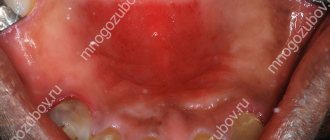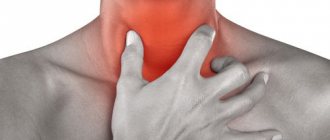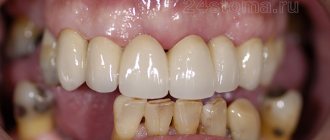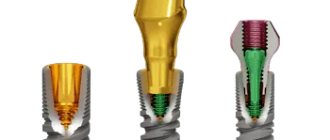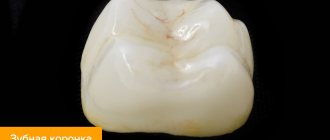Seal
One of the most popular procedures in modern dentistry is the installation of crowns. The method allows you to save a damaged tooth, restore its function, and restore the attractiveness of your smile. But sometimes after orthopedic treatment, discomfort, sharp or dull pain, and sensitivity to temperature occur under the crown. In this case, discomfort may appear both in the coming days after prosthetics and several years later. What should be done in this case?
First of all, you need to understand what is causing the pain. If very little time has passed after treatment and the discomfort is not too great, do not worry. Such pain is residual in nature. As a rule, specialist intervention is not required - 3-5 days after treatment, the discomfort goes away on its own. It’s worse when the tooth starts to hurt months or even years after prosthetics. In this case, you cannot do without a visit to the clinic.
Khashchenko Stanislav Sergeevich is a dental surgeon with extensive experience.
Possible causes of pain
Most often, before installing a crown, the dentist performs depulpation. Pulp is a loose tissue that is located inside the tooth and is penetrated by many blood vessels and nerve endings. Therefore, this procedure is colloquially referred to as nerve removal. It is generally accepted that pulpless teeth do not hurt and do not cause problems. In fact, this is not entirely true, since inflammatory processes often spread to surrounding tissues.
Inflammation is one of the most common causes of pain in a pulpless tooth under the crown. It is important to note that the factors that provoke the development of the inflammatory process are:
- Inadequate tooth preparation. A correctly performed procedure assumes that the pulp will be completely removed, and the canals will be disinfected and sealed to a physiological level. If the canal is not completely sealed, the resulting cavity creates conditions favorable for the development of bacteria. The same thing happens when using low-quality filling materials - over time, they sag and form voids into which infection penetrates, resulting in inflammation.
- Root canal perforation. As a rule, the thickness of the canal walls is small, so in complex anatomical cases they can be damaged. Perforation is the formation of a through hole, which is an “open door” for pathogenic microorganisms. Therefore, if this complication occurs, it is necessary to close it carefully.
- Incorrect fit of the prosthesis. If the crown is not installed correctly, a small gap remains between its edge and the gum or the crown and the tooth. Over time, food particles accumulate in it, which causes an increase in the number of bacteria. The result is inflammation and pain under the crown again.
- Failure to follow doctor's recommendations. Poor oral hygiene, excessive consumption of sweets, the habit of opening lids with teeth - all this can also become a factor that provokes pain. In this case, the inflammatory process occurs due to the proliferation of bacteria or traumatic damage to the tissues surrounding the tooth.
- Crack or fracture of a tooth. If a prosthetic design is chosen that is inadequate to the case or the tooth was previously severely weakened, then a root crack may occur, and then a fracture.
Frequent symptoms
The problem under consideration can manifest itself in different ways. However, there is a list of common symptoms that can help determine whether you should see a doctor:
If there is an inflammatory process, the patient experiences pain when pressing on the metal-ceramic crown or when biting in this area. This may mean that the gums under the crown are inflamed. Aching pain in the area of installation - in the presence of pus in the periodontal tissue, pressure increases and pain appears.
Swollen gums indicate a large amount of pus, a serious inflammatory process. Flux is accompanied by an increase in body temperature - it rises from 38 degrees and above. The patient may also feel echoes of pain in the head, temples, eyes, ears, teeth may randomly close and knock against each other.
An unpleasant odor under the crown also appears due to the presence of pus, a fistula (a fistula tract that allows pus to escape) or a cyst.
When a tooth hurts under the crown...
It is generally accepted that to treat a tooth, it is necessary to remove the crown. But high-quality dentures are not cheap, and they are not suitable for reuse. Therefore, it is doubly unpleasant when pain appears several months after prosthetics, and it becomes necessary to remove a crown that has not served its purpose.
In this case, patients often put off a visit to the dentist with all their might. For example, they take painkillers and antibiotics or experiment with very dubious “folk” methods. But by self-medicating, you will not solve, but will only aggravate the problem, since advanced inflammation is much more difficult to treat. If discomfort or pain occurs, you should immediately visit your dentist. Moreover, contrary to popular belief, modern treatment methods, in some cases, make it possible to do without removing the crown.
In some cases, treatment is possible without removing the crown.
Physiological reaction of the body to the installation of a dental implant
After the anesthesia wears off, the vast majority of patients experience pain in the area of the installed implant. Discomfort can be localized or diffuse, which is also considered normal. Don’t be alarmed if the pain after installing the implant radiates to the ear, throat, or head. All this is within normal limits when it lasts no more than 4–5 days and is well relieved with painkillers.
As a rule, the intensity of pain is insignificant if classical implantation is performed without combination with combined procedures. In this case, only about 5% complain of more severe pain.
If, within one day, not only implantation is performed, but also surgical procedures combined with it, this can increase postoperative pain. This happens, in particular, when a tooth is removed at once or plastic surgery of hard or soft tissues is performed at the same visit.
Mild pain after implantation is quickly eliminated with conventional non-steroidal anti-inflammatory drugs. When the syndrome is severe, the doctor prescribes stronger painkillers, which significantly alleviate the patient’s condition.
How are teeth treated under a crown?
An example is the inflammatory process in the apical (deepest) part of the root canal. In case of poor preparation, the canal may not be sealed to its full depth, which leads to the development of infection. To avoid removing the crown, resection of the apical part of the root is performed. The procedure is performed by a dental surgeon and takes from 30 to 60 minutes.
The doctor drills a small hole in the bone tissue. Through it, he cuts off the poorly sealed tip from the root and removes the purulent sac. It should be noted that this method is characterized by minimal trauma. In addition, the procedure is performed under anesthesia, so the patient does not experience pain or discomfort. After removing a section of the root, the remaining part is carefully “sealed” with a special material for further isolation from microbes.
It is important to understand that it is not always possible to do without crown removal. The final decision on the method of treatment is made by the doctor, who may prescribe an X-ray examination to clarify the cause of inflammation. This is due to the fact that additional root canals or suspected cracks require mandatory removal of the structure.
Where to find a good dentist in Zvenigorod
You can get high-quality metal-ceramic crowns in Zvenigorod from a professional in the dentistry department of the Istok Health Clinic. Our doctors carry out diagnostics and retreatment using optics (dental microscope or binoculars), which increases the efficiency and quality of work and often makes it possible to treat a tooth under a crown even in the most hopeless cases. Contact us for a consultation today and receive well-deserved high-quality service at affordable prices!
This cannot be done!
Often, in an effort to relieve pain, patients resort to rather risky methods. Remember what you should never do if inflammation starts:
- taking antibiotics without a doctor’s prescription - at best it will not bring results, at worst it will lead to serious health problems;
- warm the sore spot - elevated temperature favors the proliferation of pathogenic microorganisms, so such “treatment” will only worsen the condition;
- It is undesirable to take a horizontal position so as not to increase blood flow to the diseased tooth.
And finally, you should not let the situation take its course in the hope that the pain will go away on its own. It won't work! In order to get rid of pain, a doctor’s intervention or his recommendations are often necessary.
Pain after implantation as a syndrome of developing inflammation
It is recommended to immediately consult a doctor if you experience pain after installation of the implant:
- become stronger every day, accompanied by a feeling of fullness, twitching;
- weaken for a short time only under the influence of powerful analgesics;
- last more than 4–5 days after simple implantation and longer than two weeks when combined with other surgical procedures;
- are combined with swelling that does not subside after seven days, fluid secretion from under the gums, and a rise in temperature above 37.0–37.5°C.
The listed symptoms may indicate the development of postoperative complications, the most common of which is peri-implantitis. This is an inflammation of the tissue surrounding the titanium rod installed in the jawbone. The main cause of this pathology is infection.
Types of crowns for implants
- Metal ceramics. The most popular orthopedic design. The base is made of hypoallergenic metal and covered with a special ceramic layer. The coating perfectly imitates natural translucent enamel. The finished artificial tooth is similar in shape to a healthy element of the dentition. The advantages of a metal-ceramic crown on an implant include high strength of the material, natural color of the structure, affordable cost and ease of maintenance.
- Zirconium dioxide. High-quality material for dentures. Involves the use of metal-ceramics and ceramics. The finished design has no disadvantages. Suitable for any clinical cases. It can be used for the anterior row of the dental system.
The AlfaDent dental clinic offers the best crowns for implants.
They are distinguished by hypoallergenicity, absence of toxic components, impeccable aesthetic characteristics, structural stability, and resistance to possible displacement. The choice of one or another orthopedic system directly depends on the specific area of prosthetics and the individual preferences of the patient. The options we offer are the best, since temporary and permanent crowns on an implant can withstand significant loads and have a long service life. Ceramic products look natural in the oral cavity.
Dangerous symptoms
Standard complications are observed in almost every patient who decides to restore their teeth using implants. Most often, the discomfort disappears quickly and does not require the help of a doctor, the wound heals within a couple of days, overall health becomes much better, and the person gradually returns to his usual lifestyle.
If the pain is accompanied by such symptoms as severe redness, bleeding, enlargement of the gum pocket, the appearance of purulent discharge, swelling or numbness, then this is a good reason to consult a professional.
In addition, if an inflammatory process or implant rejection begins, severe loosening of the installed structure, high temperature, and confusion may occur. All this can cause inflammation of the maxillary sinuses, suture dehiscence, peri-implantitis, or the need to urgently remove the implant.
previous post
Ear hurts after dental implantation
next entry
Treatment
Based on the examination of the tooth, the orthopedic dentist will select treatment.
First stage
— removal of the crown if there is an inflammatory process underneath it. When it is removed, it becomes deformed and cannot be reinstalled.
Second phase
— tooth canal treatment and sanitation are carried out. Conducted by a dental therapist. After this, an appointment is made with a prosthodontist, who will install a new crown or CEREC dental module.
The reason a living tooth reacts to hot and cold is caries. You know very well how caries is treated: the doctor uses a special bur to eliminate caries until the tooth tissue is clean. Next, if necessary, the tooth is covered with filling material.
If the so-called pain responds. a dead (previously pulpless) tooth without a nerve, then in this situation we can talk about an inflammatory process around the tooth. The dentist cleans the tooth, removes the filling material, and administers the medicine. Everything is not done in one visit. The patient is prescribed drug therapy. If at a subsequent visit there is no inflammation, then the canals are sealed and a permanent filling is placed. The tooth is ready for new prosthetics.
